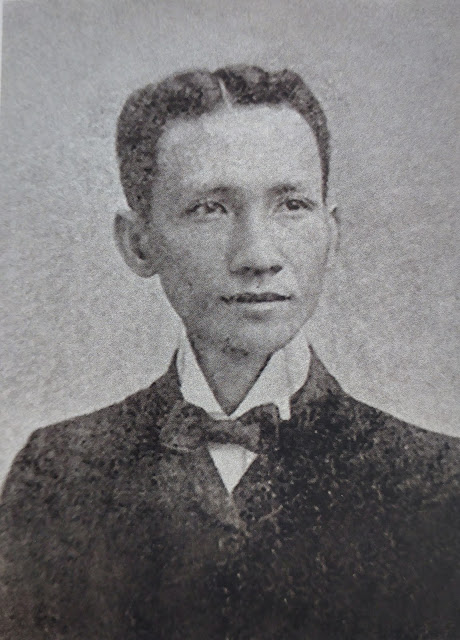Before Sergio Osmena made his mark as a local politician in Cebu and eventually moving on to the National stage, he was a journalist and newspaper owner.
His first foray in journalism was from 1896 to 1898 through his contributed articles to El Buletin de Cebu and the Manila newspaper El Comercio. Osmena at this time was a loyal subject to the Spanish Government. He was under the service of the Spanish governors of Cebu and an employee of the Audencia. He was even given the highest award that could be designated to civilians, the Medalla de Merito Civil.
By the surrender of Spain in 1898, he manifested his support for the Philippine cause. Osmena was a political tactician and survivor. He knew that the Americans would win the Philippine-American War and started immersing himself in American culture by way of learning the language. It was noted that he was one of Josephine Bracken's students in English when she lived in Cebu.
In 1900, he invited his former University of Santo Tomas Law classmates, Jaime C. de Veyra and Rafael Palma to form the first Cebuano daily newspaper, El Nuevo Dia. The Spanish-language newspaper was bankrolled by his future father-in-law, Don Nicasio Chiong-Veloso who was considered one of the richest men of that time. The maiden issue of the fledgling newspaper was published on April 16, 1900. However, freedom of expression in publications was heavily censored by the Americans. The enterprising editors led by Osmena would devise strategies on how to hoodwink the Americans and avoid censorship.
Excerpt from El Nuevo Dia's first editorial statement:
"We shall not stir up hatreds; we shall not plant distrust; seeking the national good, we shall urge harmony upon the two nations that continue to fight in our land, appeasing the fire of war and muffling the roar of artillery with words of peace and phrases of love...so that all wounds may heal and all rancor may disappear." (Mojares, 1999).
 |
| Jaime C. de Veyra and Rafael Palma. Photos from Wikicommons. |
Sergio Osmena took his Oath of Allegiance to the United States of America in March 1901. One month later on the 16th of April, he married Estefania Chiong-Veloso, one of Don Nicasio's daughters.
El Nuevo Dia continued its promotion and expression of nationalism. The newspaper was twice suspended by the American authorities due to its coverage of the various military actions in the Visayas.
The true test of El Nuevo Dia's patriotic mettle came in September of 1901. Through De Veyra's connections with the Visayan guerillas and stories that reached Cebu, the people at El Nuevo Dia learned of what happened in the town of Balangiga on Samar Island during the early morning hours of September 28th. American authorities and historians dubbed it the Balangiga Massacre but for Filipinos, it is known as the Battle of Balangiga.
The editors knew that if they placed the story front and center, the American censors would be able to block it from being published. They figured to incorporate the Balangiga story in a news item about guerilla returnees that the Americans already approved of. It worked and the Americans did not find out until the newspaper edition was already out in the public.
The Americans confiscated copies of the newspaper and ordered that El Nuevo Dia be closed due to violations. Osmena, ever a political mastermind, was able to convince the authorities that it was not their intent to sensationalize the Balangiga massacre and that by the time they reported it, the news of the military encounter was already widespread in Cebu.
Military authorities did not want their defeat in Balangiga to inspire additional insurgency against them. With 48 soldiers dead, numerous injuries, and 100 captured rifles with 25, 000 rounds of ammunition; the Americans were soundly outsmarted by poorly-equipped Filipino guerrillas.
On November 4, 1901, when the Sedition Law or Act No. 292 took effect, further muzzled pronouncements or declaration of Filipino nationalism in the areas of entertainment, politics, and journalism or publications.
The first Cebuano daily newspaper, El Nuevo Dia, did not last long as the three editors shifted their focus to have significant roles in the American Civilian Government. De Veyra (he would become a Resident Commissioner to the House of Representatives and Governor of Leyte) and Palma (would be a Philippine Senator and the University of the Philippines President) returned to Manila and Osmena immersed himself in Cebuano politics and his legal practice.
El Nuevo Dia's last issue was on April 30, 1902.
Watch 19th Century and early 20th Century Filipino Historical Figures Come Alive:
References:
The History of the Philippine Press, 1811-1910 by Jose Victor Torres. El Periodismo Filipino 1811-1910 The First Century of Philippine Journalism. Vibal Foundation, 2018.
The War against the Americans, Resistance and Collaboration in Cebu 1899-1906. Resil B. Mojares. Ateneo de Manila University Press, 1999.
Additional Readings:
9 Facts You Need to Know about President Sergio Osmeña
A Short History of Cebu's Osmena Waterworks System
Five Sculptures By Cebuano Artist Fidel Araneta
La India Chichirica: The 19th Century Filipina

Comments